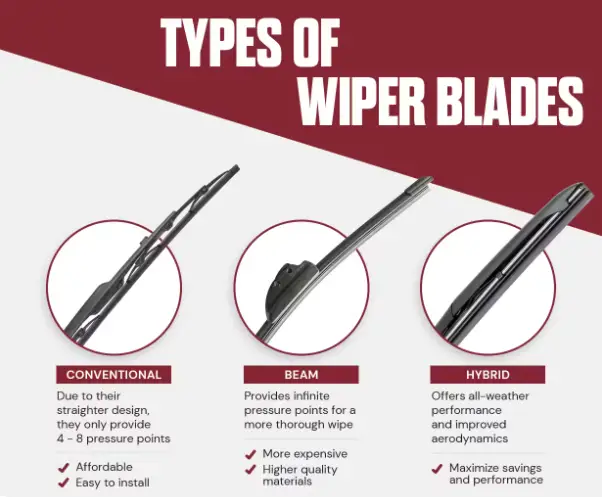To determine the size of windshield wiper blades you need, check your vehicle’s owner’s manual. You can also measure the current blades or use an online blade size finder tool.
Windshield wipers are an essential component of the vehicle’s safety system, designed to keep the windshield clear of rain, snow, dirt, and other debris that could obstruct the view. But many drivers may not realize that windshield wipers come in various sizes, and choosing the correct size is crucial for effective performance.
In this blog post, we’ll dive into everything you need to know about windshield wiper blade sizes, why they matter, how to find the right size for the vehicle, and tips for proper maintenance. By the end of this guide, you’ll be well-equipped to select the perfect wiper blades for the car, ensuring optimal visibility and safety in all weather conditions.

Credit: www.jiffylube.com
Contents
Why Wiper Blade Size Matters
Choosing the correct wiper blade size of windshield wiper blades is more than just a convenience-it’s essential for safe driving. If the wiper blades are too short, they won’t cover enough of the windshield, leaving areas uncleaned and the visibility compromised. Conversely, wiper blades that are too long may overlap or hit each other, potentially causing damage to the wiper arms or even the windshield.
The right size wiper blade ensures:
- Full Coverage: Properly sized wiper blades sweep across the entire windshield, ensuring that no large sections are left exposed to rain or dirt.
- Optimal Performance: Blades that fit correctly are more effective at removing water, dirt, and snow without skipping or leaving streaks.
- Safety: Good visibility in all weather conditions is critical to preventing accidents, especially during heavy rain or snowstorms.
How to Determine Size of Windshield Wiper Blades
There are several ways to determine the right size windshield wiper blades for the vehicle. Here are the most effective methods:
1. Consult the Owner’s Manual
The easiest and most reliable way to find out what size wiper blades the vehicle requires is to consult the owner’s manual. Every vehicle manufacturer specifies the correct wiper blade sizes for both the driver’s side and passenger’s side, and sometimes for the rear window, if applicable. The manual will list these measurements in inches.
2. Use an Online Wiper Blade Size Finder
Many auto parts stores and websites offer online tools that help you find the correct wiper blade size. You simply enter the vehicle’s make, model, and year, and the system will provide the appropriate blade sizes. Some popular auto parts retailers, like AutoZone, Advance Auto Parts, and Amazon, have these tools on their websites.
3. Measure the Existing Blades
If you don’t have access to the owner’s manual or an online tool, you can measure the current windshield wiper blades. Use a tape measure to determine the length of both the driver’s side and passenger’s side blades. Keep in mind that the two blades are often different lengths, so it’s essential to measure both.
4. Ask an Auto Parts Store Specialist
Most auto parts stores have employees who can quickly look up the vehicle’s wiper blade size for you. They may also be able to recommend specific wiper blade brands that fit the vehicle.

Common Windshield Wiper Blade Sizes
Wiper blades come in a wide range of sizes, typically between 10 inches and 28 inches in length. The size you need depends on the design of the windshield and the vehicle’s wiper system. Here’s a breakdown of common windshield wiper blade sizes:
- Driver’s Side: Typically, the driver’s side wiper blade is longer than the passenger side, as it covers a larger area of the windshield. Common sizes range from 18 to 28 inches.
- Passenger’s Side: The passenger side wiper blade is usually shorter, with sizes ranging from 16 to 24 inches.
- Rear Wiper Blades: Some vehicles, particularly SUVs, hatchbacks, and minivans, have a rear wiper blade to clear the rear window. These blades are often between 10 and 16 inches in length.
It’s important to remember that each vehicle is different, so always consult the owner’s manual or measure the existing blades to ensure you’re purchasing the correct size.
Types of Windshield Wiper Blades
While finding the right size is important, choosing the right type of wiper blade also matters. Different types of blades are designed for specific driving conditions and environments. Here are the most common types of windshield wiper blades:
1. Conventional Wiper Blades
These are the most basic and widely used type of wiper blade. Conventional blades have a metal or plastic frame with several contact points along the length of the blade. These blades are ideal for general driving conditions but may not perform as well in heavy snow or ice.
2. Beam Wiper Blades
Beam blades are a more modern option, made from a single piece of rubber or silicone. They lack the metal frame and multiple contact points found in conventional blades, which gives them better aerodynamics and pressure distribution. This design allows beam blades to perform better in extreme weather conditions like heavy rain, snow, or ice. Beam blades are also more durable and tend to last longer than conventional blades.
3. Hybrid Wiper Blades
Hybrid blades combine the features of conventional and beam blades. They have a sturdy frame like conventional blades but offer the aerodynamics and performance of beam blades. Hybrid blades are an excellent all-weather option, providing a good balance between durability, performance, and price.
4. Winter Wiper Blades
Designed specifically for snowy and icy conditions, winter wiper blades are typically made with a rubber boot that covers the blade’s frame, preventing snow and ice buildup. These blades are a great option for drivers in regions with harsh winter weather.
How Often Replace the Windshield Wiper Blades?
Windshield wiper blades wear out over time due to exposure to the elements, dirt, debris, and constant use. To ensure optimal visibility, it’s important to replace your wiper blades regularly.
Most experts recommend replacing your windshield wiper blades every 6 to 12 months, depending on usage and environmental conditions. However, you should also inspect your wiper blades periodically for signs of wear. If you notice any of the following, it’s time for new wiper blades:
- Streaking: The blade is no longer clearing the windshield evenly and leaves streaks.
- Skipping: The blade skips across the windshield instead of making smooth contact.
- Squeaking: The blade makes squeaking noises when in use, indicating it’s not gliding smoothly.
- Cracks or Tears: The rubber on the blade is visibly cracked or torn.
Regularly replacing the wiper blades is essential for safe driving, especially in rainy or snowy conditions.

Credit: autoglassmn.com
Windshield Wiper Blade Maintenance Tips
To maximize the lifespan and effectiveness of the windshield wiper blades, follow these simple maintenance tips:
- Clean the Blades Regularly: Dirt and debris can accumulate on the blades, reducing their effectiveness. Clean windshield wiper blades with a damp cloth or a dedicated wiper blade cleaner to remove any buildup.
- Check for Damage: Inspect the wiper blades for cracks, tears, or signs of wear. Even if they appear to be working fine, small cracks in the rubber can quickly worsen.
- Avoid Using Wipers on a Dry Windshield: Running the wipers on a dry windshield can cause excessive wear and damage to the blades. Always use washer fluid or water to help the blades glide smoothly.
- Remove Ice and Snow Manually: In winter conditions, avoid using the wipers to clear ice and snow from the windshield. Instead, use a scraper and defrost the windshield to prevent damage to the blades.
- Park in the Shade: Whenever possible, park the car in a shaded area to prevent the sun’s UV rays from deteriorating the rubber on the wiper blades.
Frequently Asked Questions
Here are some FAQs about size of windshield wiper blades –
1. What happens if I use the wrong size windshield wiper blades?
Using the wrong size wiper blades can cause several issues. If the blades are too short, they won’t cover the entire windshield, leaving areas uncleaned and compromising the visibility. If they’re too long, they may overlap or hit each other, which could damage the wiper arms or the windshield.
2. Can I install different-sized wiper blades on my vehicle?
It’s important to install the recommended size of wiper blades for the vehicle. Different-sized blades may not fit properly, which can lead to reduced performance and potential damage to the wiper system.
3. How do I know when my windshield wipers need replacing?
You should replace the windshield wiper blades every 6 to 12 months, but you may need to replace them sooner if you notice streaking, skipping, squeaking, or visible cracks in the rubber.
4. Can I replace windshield wiper blades myself?
Yes, replacing windshield wiper blades is a relatively simple process that you can do yourself. Most wiper blades come with detailed instructions, and the process typically involves lifting the wiper arm, removing the old blade, and snapping the new blade into place.
5. Why are my windshield wipers leaving streaks on my windshield?
Streaking can occur for several reasons, including worn-out wiper blades, dirt or debris on the blades, or a dirty windshield. Clean both the windshield and wiper blades, and if streaking persists, it’s time to replace the blades.
Conclusion
Choosing the right size windshield wiper blades is crucial for ensuring clear visibility and safe driving in all weather conditions. By consulting your vehicle’s owner’s manual, using online tools, or measuring your existing blades, you can easily find the correct size. Remember to also consider the type of wiper blade that best suits your driving environment and to replace your blades regularly for optimal performance. Following proper maintenance practices will keep your windshield wipers in top condition, helping you stay safe on the road year-round.